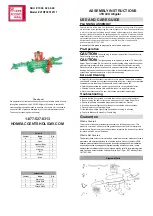
7
Tel: 1/888/525-7300 • Fax: 1/435/753-7490 • www.apgsensors.com • [email protected]
Chapter 2: Installation and Removal Procedures and Notes
• Installation Notes
•
Mount your MNU IS sensor so that it has a clear, perpendicular sound path to the surface being moni-
tored. Your sensor should be mounted away from tank or vessel walls and inlets. (See Figure 2.1)
•
The sound path should be free from obstructions and as open as possible for the 9° off axis beam
pattern.
•
If you are using a stand pipe, please see our guide to stand pipes on our website:
http://www.apgsensors.com/about-us/blog/how-to-install-a-stand-pipe
.
•
Typical tools for making electrical connections and mounting the sensor are required. If you are using a
stand pipe to mount your MNU IS, you may also need tools to install the stand pipe.
• Tools Needed
Figure 2.1
The MNU IS should be installed in an area--indoors or outdoors--which meets the following conditions:
•
Ambient temperature between -30°C and 60°C (-22°F to 140°F), unless otherwise specified.
•
No chemicals corrosive to PVDF or PBT.
•
Ample space for maintenance and inspection.
•
The sensor is located away from strong electromagnetic fields, such as those produced by motors,
transformers, solenoid valves, etc.
•
The sensor is not exposed to excessive vibration.
•
The sensor is shielded from direct sunlight or from temperatures different than the temperatures be
-
tween the sensor and the target. This is required for temperature compensation to work correctly.
•
The equipment shall be installed in a location where the external conditions are not conducive to the
build-up of electrostatic charge on the sensor. The equipment shall only be cleaned with a damp cloth.
• Physical Installation Notes












































